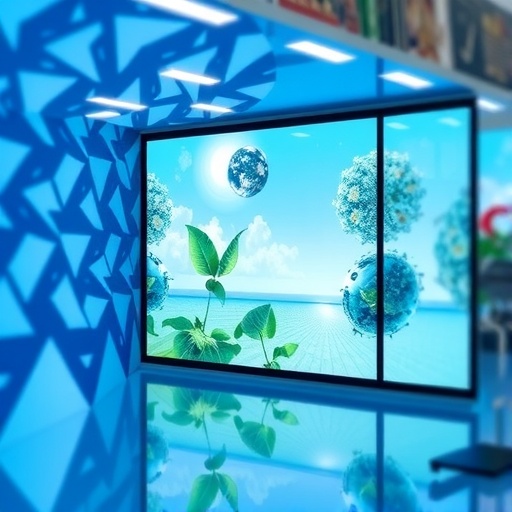Electrical engineers at Duke University are pioneering a groundbreaking technique that holds the potential to revolutionize the electronics industry by introducing fully functional and recyclable electronics at sub-micrometer scales. This innovative approach is particularly significant given the increasing environmental concerns associated with traditional electronics manufacturing, which primarily takes place overseas. With a market value exceeding $150 billion, the electronic display industry is poised for transformation through this new technology, which not only promises enhanced performance but also environmental sustainability.
The research, which will be published in the highly reputable journal Nature Electronics, presents a formidable challenge to prevailing manufacturing paradigms dominated by established global players. Aaron Franklin, a distinguished professor at Duke University, emphasizes the need for transformational technologies if the U.S. intends to bolster its manufacturing sector, particularly in areas where competition is fierce. The unique aspect of this new printing process is its ability to print carbon-based transistors that are not only effective but can also be fully recycled, showcasing a promising alternative to conventional transistors.
A critical overview of electronic displays reveals their ubiquitous role across diverse industries—from televisions and computer monitors to automotive interfaces. The traditional production processes for these technologies are infamous for their significant environmental impact, as they typically rely on vacuum-based methods that are energy-intensive and result in considerable greenhouse gas emissions. Alarmingly, estimates indicate that less than 25 percent of the millions of pounds of electronics discarded each year are actually recycled, underscoring the urgent need for more sustainable alternatives.
Franklin’s team has previously demonstrated the world’s first completely recyclable printed electronics. However, that earlier technique was limited by the capabilities of aerosol jet printing, which could not achieve details smaller than 10 micrometers. This limitation severely restricted the potential applications of their technology within consumer electronics—a challenge that the new research successfully addresses.
Collaborating with Hummink Technologies, Franklin’s laboratory has developed a method termed “high precision capillary printing.” This innovative process harnesses the natural forces of competing surface energies to draw minute amounts of ink from a pipette. This phenomenon is akin to how a paper towel absorbs liquids, emphasizing the importance of fluid dynamics in creating finely detailed printed electronics. The researchers have successfully demonstrated that they can produce features with lengths reaching tens of micrometers and sub-micrometer gaps, which are crucial in the formation of the tiny channels necessary for efficient carbon-based thin-film transistors.
The ink utilized in this revolutionary printing process consists of carbon nanotubes, graphene, and nanocellulose, all of which can be effectively printed onto various substrates, including both rigid surfaces like glass and silicon, as well as more flexible materials such as environmentally friendly paper. These advancements present a wealth of new applications and benefits that traditional electronics manufacturing processes cannot match.
For example, the recently developed sub-micrometer transistors produced through this innovative printing technique could lead to substantial improvements in the performance metrics of digital displays, which commonly rely on thin-film transistors (TFTs) to control individual pixels. Although these carbon-based transistors will not replace silicon chips designed for high-end computing, they present a compelling alternative for emerging markets where eco-friendliness and cost-effectiveness are critical.
Previous research from Franklin’s team has shown that their printed, recyclable transistors can effectively drive several pixels in an LCD display. The exciting prospect remains that these new submicrometer TFTs may soon achieve the performance metrics required for OLED display applications, a step that would further validate their technological advancement.
While the potential utility of this groundbreaking technology extends beyond displays—such as enhancing sensor integration for improved accuracy—Franklin underscores the importance of digital displays as the most promising application avenue. Notably, the new printing method demands significantly less energy and produces markedly lower greenhouse gas emissions when compared to traditional TFT manufacturing techniques, thus highlighting its environmentally friendly footprint.
Despite the considerable promise shown by this innovative technology, securing adequate investment and support to overcome remaining obstacles is crucial for its successful commercialization. There are ongoing challenges that Franklin hopes to navigate in the near future, particularly given recent setbacks regarding funding programs formerly aimed at supporting such groundbreaking research.
The sustainability and performance of these new submicrometer carbon-based transistors could usher in a new era for electronics manufacturing. As the demand for greener technologies continues to escalate, the implications of Franklin and his team’s research may significantly influence both industry practices and environmental policies moving forward.
Ultimately, the fusion of cutting-edge printing technology with sustainable materials could change the landscape of electronics production. Researchers are optimistic that these advancements can lead to more eco-friendly products while simultaneously assisting in reclaiming a competitive manufacturing edge for U.S. industry.
The comprehensive investigations conducted by Franklin and his team serve as a profound example of how innovative research can lead to practical solutions for some of the most pressing environmental issues facing the world today. As the technology matures, it may redefine standard practices within the electronics industry, representing a critical step toward a sustainable future in manufacturing.
Subject of Research:
Article Title: Capillary flow printing of submicrometre carbon nanotube transistors
News Publication Date: 17-Oct-2025
Web References: Duke University News
References: Nature Electronics, DOI: 10.1038/s41928-025-01470-7
Image Credits: Credit: Alex Sanchez, Duke University
Keywords
Printed Electronics, Carbon Nanotubes, Graphene, Thin-Film Transistors, Sustainable Manufacturing, Recycling, Electronic Displays, Eco-friendly Technology, Energy Efficiency, Semiconductor Technology, Innovation in Engineering, Environmental Impact
Tags: advancements in sub-micrometer scale technologycarbon-based transistors technologychallenges to traditional manufacturing paradigmsDuke University electrical engineering researchelectronic display market transformationenvironmental benefits of digital displaysenvironmentally friendly electronics productionimplications for U.S. manufacturing sectorinnovative approaches to electronics sustainabilityrecyclable electronics manufacturingrevolutionary printing techniques for electronicssustainable electronics industry practices





